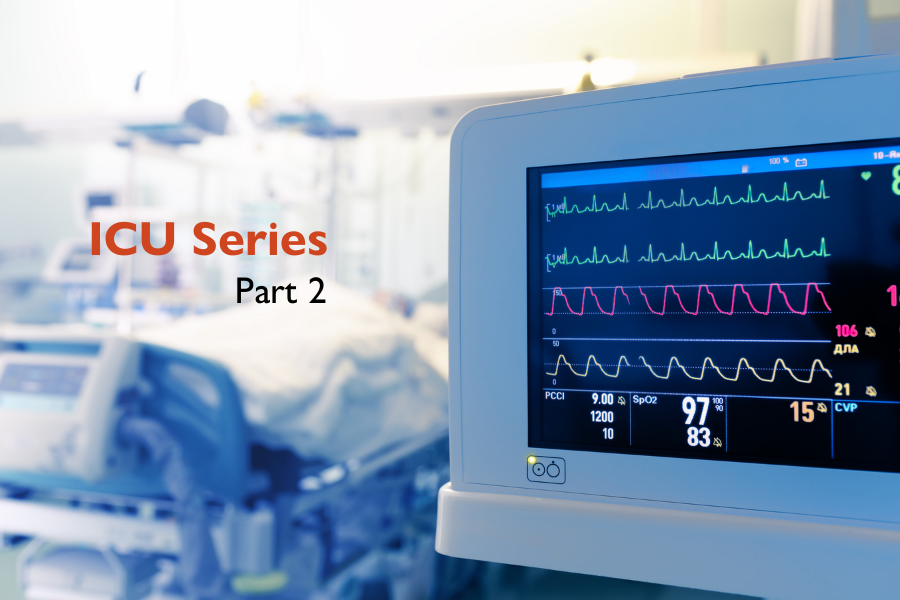Dietitian Blog, MNT Guidelines, Nutrition Support | Aug 9 2022
Part 2: ICU abbreviations and acronyms | ICU series

When working in the ICU, there is a ton of new terminology to keep track of. We’re explaining the most important ICU terms and acronyms that you need to know.
ABG: “Arterial blood gas;” measures proportion of oxygen and carbon dioxide in the blood. Often used to determine what level of respiratory support a patient needs or if they are appropriate for extubation.
APACHE II: “Acute Physiology and Chronic Health Evaluation II;” assesses disease severity and used to predict clinical outcomes for critically ill patients. The score ranges from zero to 71; a higher score indicates higher disease severity and likelihood of poor clinical outcomes.
CRRT: “Continuous renal replacement therapy;” a 24/7 form of hemodialysis. May be used in patients who are too unstable for traditional hemodialysis.
ECMO: “Extracorporeal Membrane Oxygenation;” life-sustaining treatment that can support cardiac and/or pulmonary failure. The machine filters the blood outside the body, oxygenates it, then returns it to the body. Listen to our podcast, “Dietitians Only,” to learn how ECMO impacts a dietitian’s nutrition interventions.
FiO2: “Fraction of inspired oxygen;” ventilator setting. Indicates the concentration of oxygen in the air the patient is receiving. Room air is approximately 20% oxygen. FiO2 of ~35% typically means the patient is nearly ready for extubation. The higher the number, the more support the patient needs to maintain blood oxygen levels. 100% is the highest level.
GCS: “Glasgow Coma Scale;” used to measure how alert and responsive a patient is. Assigns point values to certain types of eye opening, verbal, and motor responses. A score of eight or less indicates the patient is in a coma. Fifteen is the highest score and indicates mild or no impairment.
NUTRIC: “Nutrition Risk in the Critically Ill;” scoring system that estimates and predicts which patients are at highest nutrition risk and are most likely to benefit from nutrition intervention. The score ranges from zero to ten; a higher score indicates higher nutrition risk.
PEEP: “Positive End Expiratory Pressure;” ventilator setting. Indicates how much pressure is needed at the end of an exhalation to keep the lungs inflated. A PEEP of five is normal. The higher the number, the more severe the lung damage.
SCUF: “Slow Continuous Ultrafiltration;” a type of dialysis that is primarily used for fluid removal. Appropriate for patients who are hemodynamically unstable.
Sedation vacation (or holiday): A temporary cessation of a vent patient’s sedation. Typically done to assess whether the patient can follow commands, take independent breaths, check neurological function, etc.
SLED: “Sustained Low Efficiency Dialysis;” dialysis treatment that is stretched over several hours. Features longer sessions than traditional hemodialysis, but shorter than CRRT. Used for patients who are hemodynamically stable. Imagine a “gentle” dialysis.
SOFA: “Sequential Organ Failure Assessment;” objective scoring system that assigns points based on the extent of severity of organ failure. Score ranges from seven to 15; risk of mortality increases as the score increases.
This is part two of our ICU blog series. Part one discusses metabolic changes that occur during critical illness. Still want more? Don’t miss part three of our ICU blog series.
Dietitians On Demand is a nationwide staffing and recruiting company for registered dietitians, specializing in short-term, temporary and permanent-hire positions in acute care, long term care and food service positions. We’re dedicated to dietitians and helping them enhance their practice and excel in the workplace. Check out our job openings, request your coverage, or visit our store today!
References
Fuentes S, Chowdhury YS. Fraction of inspired oxygen. Stat Pearls. https://www.ncbi.nlm.nih.gov/books/NBK560867/. Accessed October 14, 2021.
Kitchlu A, Adhikari N, Burns K.E.A. et al. Outcomes of sustained low efficiency dialysis versus continuous renal replacement therapy in critically ill adults with acute kidney injury: a cohort study. BMC Nephrol. 2015;16(127). https://doi.org/10.1186/s12882-015-0123-4
Knaus WA, Draper EA, Wagner DP, Zimmerman JE. APACHE II: a severity of disease classification system. Crit Care Med. 1985;13(10):818-829.
Jones AE, Trzeciak S, Kline JA. The Sequential Organ Failure Assessment score for predicting outcome in patients with severe sepsis and evidence of hypoperfusion at the time of emergency department presentation. Crit Care Med. 2009;37(5)1649-54.
The Nutric Score. Critical Care Medicine website. https://www.criticalcarenutrition.com/resources/nutric-score. Accessed October 14, 2021.
Who we are
Dietitians On Demand is the nationwide leader in providing dietitians with jobs they love. If flexibility, competitive pay, a full benefits package, free CPEUs each month and a team dedicated to dietitians sound good to you, apply to our positions today.





